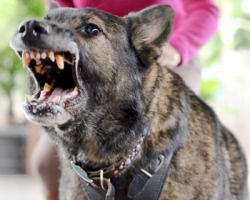
I walk my dog Gabby several times a day. Our neighborhood is full of dogs and it’s always fun when her doggie friends are out and they can play together. Usually these walks are uneventful. But I will never forget one walk –probably the scariest thing I’ve ever experienced. Gabby and I were enjoying our stroll when out of nowhere, a snarling dog appeared. Its teeth were barred in an awful grimace. It charged us at top speed and in about three seconds, it was right next to me. It then leapt into the air and its huge mouth grabbed Gabby by the head.
Honestly, what happened next is a blur. I remember screaming the dog’s name and I remember trying to pull Gabby away. I also recall trying to pry the dog’s mouth open to release my dog’s face. Poor Gabby was whimpering and wouldn’t fight back. Finally, the owner came out and the dog finally let her go. Who knows what damage could have happened to both my dog and me? Fortunately, I suffered only a small bite on my hand and Gabby a small tear on her ear and a puncture wound by her eye. Later that week, I learned that Gabby wasn’t the only one who had been attacked by this dog.
So, what in the world is the right way to handle a dog attack? I know now that I did almost everything wrong. There’s some truth to the adage that “dogs can sense fear.” If one panics, the dog will probably feel more confident in its attack, or one may appear threatening to the dog. Neither of these represents a good situation. Thank goodness I didn’t run because that could have spelled even more disaster. All dogs are chasers and friendly or unfriendly, if a person runs, dogs will give chase.
“Be aware of your surroundings and look for warning signs,” says dog trainer Yaiza Magdalena. “Most dogs are not aggressive but curious or defending what they perceive as their territory. It is important to be able to tell if a dog is just playing or is being aggressive. If the dog approaches you with its head held high or low, it is probably not going to attack. A dog whose head is level means business. A loping gait means the dog is playful and checking you out. An even, steady run means business.”
Trainer Liz Palika has some good advice: “A verbal interruption is the fastest thing you can do. Don’t sound like prey – don’t scream – as that could excite the attacking dog even more. Sound like you’re someone in charge.
“If a dog has locked onto another animal’s neck or a human limb, pick its back legs up and hold it in the air. This prevents it from pulling, ripping and causing any more damage. Put a cloth over the dog’s head. This can make them let go.”
Palika says, “Spray the dog with a strong jet of water or air spray.” That’s a lot to think about, but now that I know what to do, I could have gone for the water hose and or taken off my jacket to put over the dog’s head. The bottom line is: Be prepared. Dog owners at some point might come across an aggressive dog and thinking about what to do before it happens could be the key to preventing serious injury. Most importantly, try to stay calm, as hard as that might be.
As for Gabby and me? Now, if I see an unfamiliar dog, I don’t approach it. I stay aware of my surroundings and I stay far away from that dog in our neighborhood. Once bitten, twice shy.
Lori Fusaro has been voted the best portrait photographer by FoxTV three years in a row. She lives in Culver City with her husband, four cats and dog. Contact: Lori@FusaroPhotography.com, FusaroPhotography.com.
